Hospitality Lawyer on “LIFESTYLE” hotel mixed-use development. Are Valencia and Miraval the new paradigms for “lifestyle” hotel mixed-use? | By Jim Butler
By Jim Butler, Hotel Lawyer | Author of www.HotelLawBlog.comHospitality Lawyer on “LIFESTYLE” hotel mixed-use development. Hotel mixed-use has emerged as one of the few ways hotel developers may be able to make a new development economically feasible, with skyrocketing construction costs. It has also become one of the hottest things going as developers of other real estate uses (shopping centers, office, retail, residential and entertainment) discover the big “IRR Premiums” that may harvested from well-planned and tightly integrated hotel mixed-use projects. (See, my earlier postings on www.HotelLawBlog.com from The Hotel Developers Conference® in Rancho Mirage. about how green hotels may be in all our futures, hotel mixed-use is the pass key to unlocking new development and bigger profits, and the perspectives of the most successful leaders in hotel mixed-use today)
In fact, many of our clients and industry friends have talked about the “exponential” success of hotel mixed-use developments with enhanced profits and values flowing both ways. Hotels get a boost from other real estate uses in the project, like the Hotel Valencia Santana Row getting 150%-180% RevPAR penetration (i.e. more than 150%-180% of its “fair share” of the competitive set). And the accompanying residential, retail or other uses get a huge boost in value and traffic from the hotel and the other integrated components. (See, “Hotel Mixed-Use . . . pass key to unlocking new development and bigger profits?”)
Two of the touchstones for these new models of success are “lifestyle” and “integration.” Today we are going to bear down on the lifestyle component.
What is lifestyle hotel mixed-use development all about?
Some think that “lifestyle” is just the current incarnation of “boutique” and find that boutique is now passé. The boutique concept, which many think was invented by Kimpton and extended by others like Joie de Vivre and Morgans, originally implied a smaller hotel, with high levels of art and design, and highly personalized service. Boutiques usually had innovative signature restaurants and something distinctive — whether quaint or hip, stylish or lavish. Some argued that boutiques had to be fewer than 100 rooms, while others argued for more if the feeling of intimacy maintained. Then Las Vegas introduced boutique hotels of “only” 1,000 rooms. I guess that is “intimate” if compared to 5,000 rooms, but something gets lost in the translation.
Well, the leaders of boutique — such as Kimpton, Joie de Vivre and Morgans — have all continued to advance their concepts. Maybe the word “boutique” is passé to some, but the inventors of the concept have continued to keep the idea fresh and appealing to big segment of travelers.
Still, “lifestyle” implies something more than “just” distinctive, small, comfortable or hip. It suggests integration of component parts for a meaningful and exciting live-work-play environment. It is likely “ahead of the curve” and involves art, design, fashion, and dynamic and colorful environments that relate to a whole demographic segment. It is likely to be specialized and focused in order provide this differentiating quality – a quality that makes people feel “special,” “exclusive,” with a warm sense of personal belonging. These photos of Valencia’s Santana Row illustrate how the retail, residential and hotel components of the hotel mixed-use project work together to provide an attractive and exciting “lifestyle” experience.
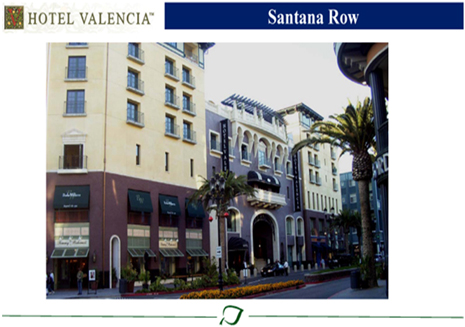
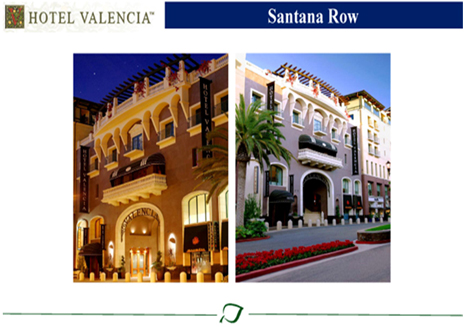
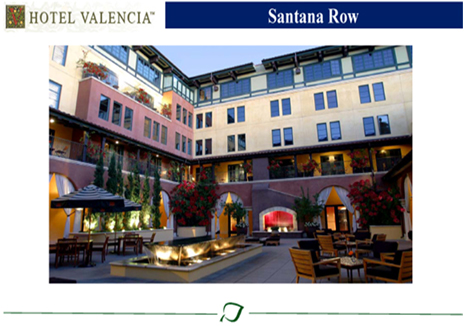
So why the fuss over lifestyle in hotel mixed-use projects?
Concepts of “lifestyle” cross asset classes. All real estate classes focus on “knowing your customer,” providing a distinctive product, and delivering a superior experience. Indeed, these principles have been the foundation of the retail, entertainment, and residential segments of the real estate industry for years. Maybe office and hotels are late to the concept, but the principles apply to all real estate classes, and when real estate uses, brands, and setting are properly selected, with similar focus, the results can be astounding.
It is the right mix of real estate uses in a hotel mixed-use project that creates great value. That is why Marty Collins of Gatehouse reports that his W Hotels and Residence create a 50-100% value premium. That is how Valencia reports a 150-180% RevPAR penetration at Santana Row and has generated record retail sales for the merchants in the project as well as their landlords. And that is why General Growth Properties (one of the largest owners of shopping malls in the world) is looking at its 200+ malls and retail centers to see where it can accomplish superior results — and believes that it may have identified 80 opportunities.
How does the “IRR Premium” for hotel mixed-use developments work? Can it be measured or is it all “touchy feel-ey”?
As a valued client of our Firm, we were fascinated to learn that General Growth Properties has found that 32% of U.S. domestic leisure travel activities are spent on shopping. This represents a trip volume of 490.1 million trips, with an average of $372 per household spent on each trip (excluding the transportation). An amazing 77% of those trips were overnight, and averaged 2.9 nights at a hotel. Here's what that looks like in graphic presentation:
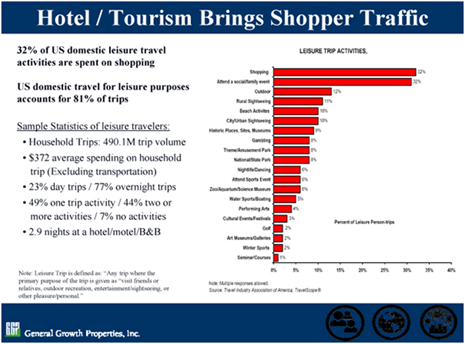
Understanding this in the terms of a specific project, like the Dallas Galleria Mall is an interesting exercise. This chart shows how only 32% of the Dallas Galleria’s business came from local shoppers, and 32% of the business came from customers 50 miles away or more. What makes a customer come here to shop?
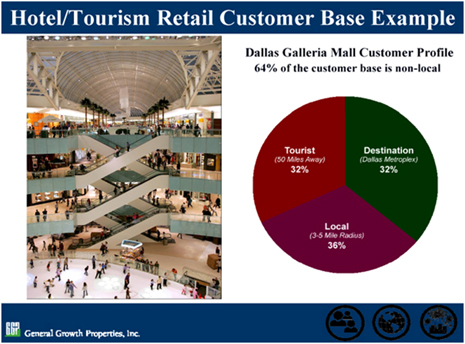
With more than 200 malls across America, General Growth spent a lot of resources understanding the synergies of hotel mixed-use. The chart below summarizes their conclusions as to the performance premiums for hotel mixed-use, where a) hotels are within Master Planned Communities (MPC), b) with an MPC and retail, and c) adjacent to Retail.
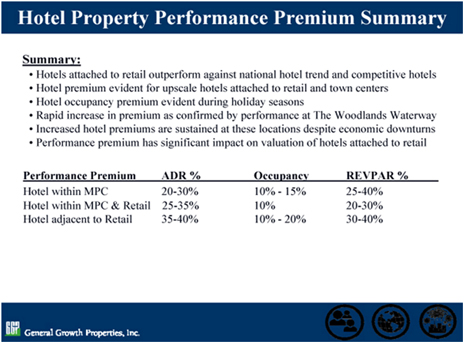
But as I said earlier, the benefit of hotel mixed-use flows both ways — each component of the mixed-use project enhances and improves the other. So here is GGP’s analysis of the enhanced performance of its office component at The Woodlands, their MPC in Houston.
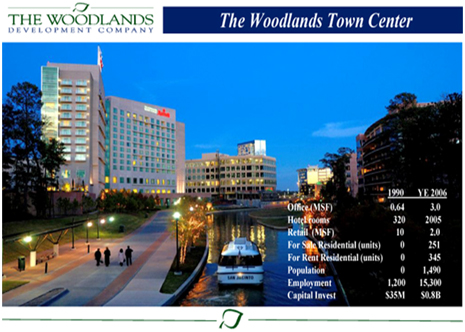
Certainly some of the benefit is attributed to superior product, and to limited supply in a Master Planned Community. Nonetheless, a 1% vacancy factor compared to 12-14% in the immediately surrounding market areas, and average rent premiums of at least 30% are pretty strong evidence for the value of hotel mixed-use. (These figures -- and others --shared by GGP execs at The Hotel Developers Conference® earlier this month created a flurry of interest among participants!)
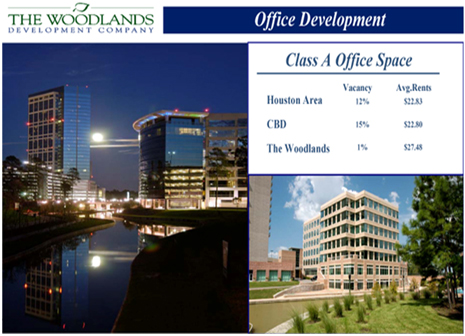
And if the earlier synergies of leisure travelers loving to shop were lost on you, here is a chart showing how GGP figures that its retail sales increased by more than 403% from 1995 to 2006 — at least in significant part because of the hotel mixed-use nature of the project (and also all the usual developer’s points of pride, including superior design, location, and exclusivity created in an MPC).
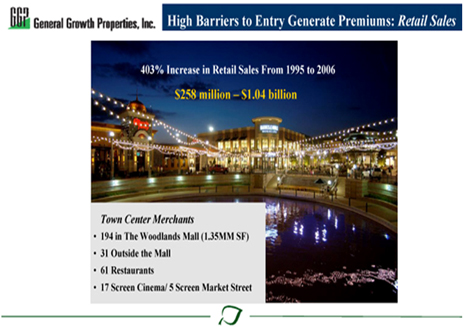
The upscale shopping experience is also a vital component of Santana Row’s success, as is the dining, entertainment, and lodging. Hotel Valencia occupies a critical space in Santana Row’s urban oasis. Inspired by the scale, mix, and feel of European boulevards, Santana Row offers a dynamic lifestyle experience. More than “just” a 212-room chic, contemporary hotel for discerning travels, Hotel Valencia Santana Row is at the very heart of this experience: “it is exactly where you want to be”.
Bringing it all home.
Hotel mixed-use can provide customers and guests with great experiences and provide owners and operators with exceptional value. But one size does not fit all. It is not a panacea! Like all successful projects, you have to do your homework.
The results from successful hotel mixed-use projects — with enhanced values radiating from each component of the project to all others — can be absolutely compelling. It is documented. It can be dramatic and make the difference between rich profits and bankrupting losses. But it simply does not work everywhere. And there is an art as well as a science to making it work.
Stayed tuned, as we will talk more about that later…

Jim Butler
Phone: +1 310 201 3526
Email: jbutler@jmbm.com
JMBM Global Hospitality Group
www.jmbm.com/PracticesIndustries/Practices/GlobalHospitalityGroup
1900 Avenue of the Stars, Seventh Floor
USA - Los Angeles, CA 90067
Phone: (310) 203-8080
Unlocking Value in Hospitality: The New Era of Hotel Mixed-Use Development in Qualified Opportunity Zones | By Guy Maisnik
Summertime Blues: Corporate Finance Faces a Financial Reporting Reckoning | By Marianne Martin
One Big Beautiful Bill Act – Key Tax Provisions

